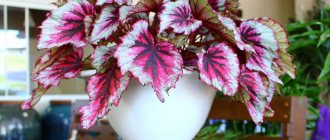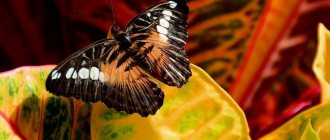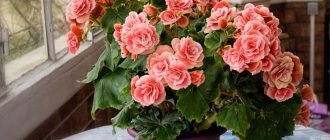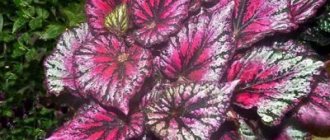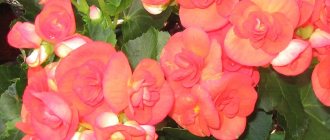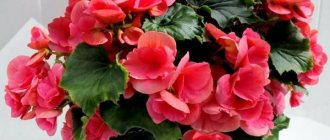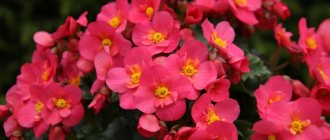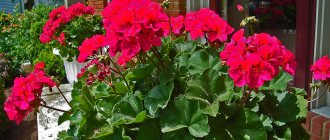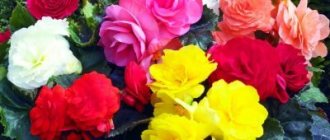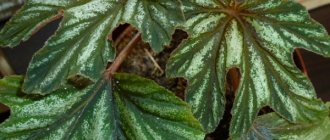Tuberous begonias bloom profusely and brightly, their luxurious flowers resemble roses, carnations, camellias, peonies, daffodils... The great advantage of tuberous begonias is their ability to add festive decoration to the shaded corners of the garden, bringing their bright colors there. Numerous elegant flowers of various tuberous begonias decorate gardens from June to September, and apartments and frost-protected balconies even longer - from late spring to late autumn.
Begonia tuberous. © Maja Dumat
Tuberous begonia (Begonia x tuberhybrida). A herbaceous plant with a thick underground tuber-rhizome, succulent translucent stems, height from 20 to 80 cm. The leaves are alternately arranged, heart-shaped, asymmetrical. Flowers, depending on the variety, are simple, semi-double, double. Colors range from white to dark red, yellow, orange, except shades of blue, cyan, violet. The flowers are heterosexual, monoecious, that is, there are male and female flowers on the same plant. The shape of the flowers is single, semi-double and double. With additional pollination, tuberous begonia produces seeds well, of which 1 g contains from 80 to 120 thousand. Flowering occurs from May to November. In winter, begonia loses its leaves and enters a dormant period.
The name Begonia x tuberhybrida was proposed by A. Voz, since there was a large group of hybrids, as well as mutations from them, united by the presence of a perennial tuber. According to various sources, from six to nine species took part in the crossings, but the Bolivian begonia (Begonia bolimensis) is considered the main one. The first hybrid varieties went on sale in England in 1869 and were grown in greenhouses as beautiful flowering plants for rooms. The Belgian Louis Van Houtte was the first to cultivate begonia in open ground. Thanks to his work, begonia tubers began to be grown almost like tulip bulbs, and the city of Gand became the world center for tuberous begonia. In the 90s of the last century, about 50 million tubers were produced there per year.
The selection of tuberous begonia proceeded very quickly, since the hybrids produced a lot of seeds, and the original species were distinguished by great diversity in flower shape and color. Already in 1874, V. Lemoine introduced gardeners to terry begonias. To this we can add that by the end of the 19th century there were about 200 names of forms and varieties. In a relatively short period of time, by 1900, hybrids with all the characteristic colors and double flowers went on sale. Further selection led to the creation of garden groups with flowers of various sizes: giant (gigantea) - up to 20 cm, large-flowered (grandiflora) - with flowers whose diameter is 8-10 cm, abundantly flowering (floribunda) - 8-12 cm and multi-flowered (multiflora ) – 5-7 cm in diameter.
Nowadays, selection proceeds in two directions. The first of them is the creation of heterotic hybrids, more suitable for open ground. Most often they are grown annually from seeds. The second, more traditional, direction pays more attention to the variety of flowers in color and shape. Such varieties are most often sold as tubers, although heterotic hybrids can also be sold as tubers.
The varieties and hybrids of the gigantea group are distinguished by the greatest variety in the shape of flowers and petals. Double flowers resemble camellia, peony or anemone. The petals of large flowers can be heavily ruffled or gathered (form crispa), or cut or fringed (form fimbriata).
A special place is occupied by ampelous tuberous begonias (Begonia pendula flore pleno), which were obtained by crossing various forms of the multiflora group. They have semi-double and double graceful flowers on thin drooping pedicels. But their advantage is not only decorative - they tolerate the sun well, bloom early and abundantly. Therefore, they are readily used in flower beds.
Begonia tuberous. © Laura Flanders
Tuberous begonia (Begonia x tuberhybrida) belongs to the genus Begonia. The genus contains, according to various sources, from 400 to 1000 wild species of plants of the begoniaceae family, growing in tropical and subtropical regions of America, Africa and Asia. Begonia was first introduced to Santo Domingo in 1690 by botanist Charles Plumiero.
The name of the genus Begonia comes from the name of the great lover and collector of the plant, M. Begon, who lived in Santo Domingo in the 17th century; C. Lineus, who described it, named begonia in his honor. In Russia, begonia has been known for a long time, and after the French fled from Moscow in 1812, it received an interesting Russian name - “Napoleon's ear”, since the outline and reddish color of the underside of the leaf of some types of begonia really looks like a large frostbitten ear.
Peculiarities
- Light : depending on the variety (some varieties are more tolerant of bright summer sun than others). In indoor conditions, bright, diffused light is better.
- Temperature : for normal flowering, depending on the variety, usually at least 10°C.
- Watering : regular in summer, without drying out. During the dormant period, the substrate with wintering tubers is occasionally moistened.
- Humidity : preferably high. For plants planted in containers, spraying is recommended.
- Feeding : in order for begonias to develop foliage, after planting, they need to be fed two or three times with an interval of seven days with potassium nitrate, and then with a complete complex fertilizer with a low nitrogen content.
- Pruning : fast-growing hanging begonias are pinched to form side shoots.
- Dormant period : in winter. It is advisable to store tubers in sand or peat at temperatures around 12°C. The rest period lasts about 3-3.5 months. To avoid drying out of the tubers, occasionally the substrate is carefully moistened.
- Transplant : annually at the end of the dormant period.
- Reproduction : tubers, cuttings, seeds (less often).
Elatior
They are sometimes called winter begonias (Begonia x hiemalis Fotsch.) because they are able to bloom profusely in winter. These begonias are probably the most common and favorite types of begonias. They are often confused with tuberous begonias, however, they are a hybrid species resulting from crossing Socotrans and tuberous begonias.
The result was original, stunningly beautiful, evergreen perennial begonias with thick reddish stems, small asymmetrical leaves and bright large flowers. They are classified as tuberous begonias solely because of their pedigree. They do not form tubers and do not die off in winter. Elatior begonias have the most abundant and long-lasting flowering. These are favorites among domestic begonias.
The height of the bush does not exceed 40 cm. The shoots are thick and fleshy. The heart-shaped leaves are located alternately on the shoots. Their length is about 8 cm. The edges of the leaves are cut. The front side of the leaves is glossy, rich green, and the back side is matte, light green. The flowers are collected in inflorescences on long peduncles. Flowering occurs in winter.
"Christine"
A very beautiful variety. The flowers have a pleasant aroma and look like white and pink marshmallows. I would have eaten it!
"Jeanne d'Arc"
A very elegant begonia. Its flowers are soft pink, but there are apricot and cream shades. The petals come with smooth edges and jagged edges, which makes the flowers look like carnations.
Begonia "Renaissance" (pictured Renaissance Nana)
This series has densely double flowers with corrugated petals and heavily indented leaves. Depending on the color of the flowers, the names change: “Renaissance Rot”; "Renaissance Orange"; "Renaissance Rosa" and others.
"Berseba Red"
The bush is from 30 to 40 cm high, blooms with double, bright red flowers.
"Borias"
A herbaceous plant about 25 cm high. It belongs to the ever-flowering begonias. Suitable for creating winter bouquets.
Dependence on growing conditions
The relationship of tuberous begonias to light varies. Plants with small flowers develop well in sunny places, while large-flowered plants grow better in partial shade. The same is true for ampelous forms: the smaller the flower, the better the plant feels in the sun. Both tall begonias with large flowers and hanging begonias should be planted in places protected from the winds so that the fragile succulent shoots do not break.
Begonia tuberous. © Maja Dumat
Due to its complex hybrid origin, the attitude of different groups of tuberous begonia to the temperature regime is different. If in general this plant can be considered more heat-loving than ever-flowering begonia (B. semperflorens), then the most demanding varieties of large-flowered begonias are the most heat-demanding, and the heterotic hybrids of the floribunda group, which bloom well at a temperature of about 10°C, are relatively cold-resistant, while In large-flowered begonias, at this temperature, flowering weakens, and the buds may fall off. None of the varieties of tuberous begonia can tolerate even light frosts. Plants especially suffer from cold winds; the edges of their leaves may turn black. But hot, dry weather is not conducive to good growth and flowering. In dry, heated soil, the roots stop growing and may die completely, flowers, leaves and buds fall off, and an almost bare stem remains. Begonia reacts poorly to low air humidity.
All begonias are moisture-loving plants; with a lack of moisture, their leaves become dull and their buds fall off. But excess moisture causes various rots to appear.
In places exposed to the wind, plants suffer more, especially dark-leaved varieties and hybrids. It can be assumed that only heterotic hybrids with small flowers can grow in open flower beds.
Landing
It is better to plant tuberous begonia in open ground in early June. On closed loggias it is possible earlier - in mid-May. If the temperature drops, it must be covered. Purchased seedlings, including flowering ones, can be kept at home in a bright window, but not in bright sun, providing it with sufficient humidity.
When planting, you need to very carefully remove the seedlings from the pot, especially if they are overgrown, since the succulent stem can easily break. Seedlings from seeds are buried 1-1.5 cm lower than they were in the pot. Tall seedlings and plants obtained from tubers should be planted 2-2.5 cm deeper to provide stability. It is recommended to place slowly dissolving fertilizers containing potassium and phosphorus in the hole and pour them well. It is better to plant tall varieties of begonias in flower beds at a distance of 30-35 cm from each other, compact hybrids - at 25-30 cm. They are planted in containers, especially ampelous forms, at 10-15 cm.
Begonia tuberous. © Maja Dumat
Care
The main thing in caring for tuberous begonia is proper watering. To maintain flowering in hot, dry weather, you need to water early in the morning, but not with cold water. When watering during the day, burns appear on the leaves, and subsequently they fall off. If you water overheated soil with cold water, the roots will die.
To increase the resistance of plants when heat sets in, they need to be sprinkled with growth substances (humate, epin, zircon). It is advisable not only to water begonias in containers, but also to spray them with warm water in the morning and evening.
In order for begonias to develop foliage, after planting they need to be fed two or three times with an interval of seven days with potassium nitrate, and then with a complete complex fertilizer with a low nitrogen content. Excess nitrogen causes plants to stretch out and, in damp weather, contributes to their rotting.
Until the plants grow, it is necessary to keep the soil loose and remove weeds.
Tall begonias with large flowers should be tied to small stakes to prevent them from breaking in the wind or during heavy rains.
In containers, fast-growing ampelous begonias are pinched to form side shoots. In addition, to prevent the shoots from rotting when they become very thick, it is recommended to either distribute them throughout the container or remove excess and weak ones.
How to care for bush begonia at home
Planting and caring for begonia, growing in the form of a bush, can be easily mastered even by a novice gardener. The main thing is to choose a place in the house where the plant will receive enough light. You also need to devote time to regular watering and fertilizing.
Lighting
Bush begonias prefer places with good lighting, but not direct sunlight. If the leaves get too much sunlight, brown spots will form. Low, highly branched bushes with fragile stems feel most comfortable on the windowsills of eastern and western windows. Frequently turning and moving bush begonia is not recommended.
Temperature and humidity
The optimal temperature is from 18 to 22°C. In hot weather, evaporation increases, so the need for water increases. The plant may not have enough moisture in the pot. You will need pallets with constantly moistened pebbles, on which it is convenient to place pots of flowers.
If it is too hot on the window, then it is recommended to move the bush begonia deeper into the room. You can shade it with a sheet of parchment paper.
Watering and spraying
Bush species love abundant watering, but when caring for begonias in a pot, the intervals between them are important. In summer they irrigate more often, on average 1 or 2 times a week. Pour water into the tray, after 10–15 minutes the excess liquid is drained. The leaves and flowers are not wetted, only the air is moistened from a spray bottle. In winter, watering is significantly reduced, but the soil in the pot should not dry out completely.
Conditions for abundant flowering
The most commonly grown varieties of bush plants in rooms are Begonia semperflorens.
For the development of buds in spring, a period of relative rest in winter at a temperature of about 15°C is important. In February, begonias are pruned and replanted if necessary. From spring to autumn, flowers bloom, striking in the variety of colors of the petals. The color range is from white to dark red.
Begonia Elatior can bloom all year long, provided there is light and warmth. The corollas are simple, semi-double or densely double. The latter look like mini roses.
Elatior begonias adapt to day length. If they receive at least 14 hours of sunlight, shoots and leaves grow better. With less than 13 hours of light, flowers usually form. Therefore, Elatior begonias are also called “winter”.
You can regulate flowering by controlling the length of daylight hours, for example, putting plants in a closet for part of the day or adding additional light to lamps.
You may be interested in how to care for indoor roses.
Transplanting bush species
The need for replanting largely depends on the type of begonia, perennial or annual. Bush species in pots for growing indoors are perennials. Most are compact plants that are repotted when the pot becomes too small for roots.
Replanting at home is required after purchasing begonias in a store. Usually the soil in a pot with such a plant is depleted and should be updated.
Plants adapted to the house are removed from the container once a year, the old soil is shaken off and the bush is placed in a more spacious pot. The soil for begonias should be light, loose, and nutritious. If it is a ready-made substrate from the store, then the transplanted plant is not fed for a month.
Overwintering, propagation by tubers
At the end of August, before frost, you need to decide what to do with the tuberous begonia next: leave it at home for further flowering or dig it up to obtain tubers. In the first case, the plants are transplanted into a pot, preserving the root system if possible. In the second, without cutting the stem and leaves, they dig it up with the largest possible lump and place it to dry in a well-ventilated, shady place, protected from rain.
With a short autumn day, the leaves gradually dry out, and nutrients from them enter the tuber. Thus, a large tuber is formed within one month. In industrial cultivation, in addition, at the moment of mass flowering, flowers are removed from plants.
At the end of the growing season, begonia should be covered from frost at night with paper, gauze or plastic wrap. After flowering, begonia goes into a dormant state. During this period, watering is reduced and the plants are moved to a dark place. After about 1-1.5 months, the above-ground part of the begonia dies, after which the tuber is left in the ground for another 2-3 weeks. After this, the tubers are dug up and placed in a box with sand or peat. The substrate in which the tubers are stored is slightly moistened from time to time so that the tubers do not dry out. The box with tubers is kept in a cool room with a temperature of 12-14°C. 2-3 months before planting in balcony boxes, the tubers are removed from the sand and planted in pots with soil. Tubers have an upper and lower part. On the upper part, which is flatter or concave, there are buds that look like bumps and bumps. The lower part is smoother, slightly convex, and roots will form on it after jigging. Tubers germinate well at a temperature of 22-24°C and regular watering. Old tubers can be cut into 2-4 parts, so that each piece has 3-4 buds. It is advisable to sprinkle the cut areas with charcoal powder.
Begonia tuberous. © Maja Dumat
When purchasing tubers, you need to pay attention to their size and type. The diameter should be at least 3 cm; for ampelous small-flowered begonias it is slightly smaller. Well-cleaned tubers should be smooth and dense at the top.
Selection of tubers and growing features
The plant comes from Africa and South America . It is because of this that problems may arise when growing it, since the flower is light-loving and also requires moist soil. And the climate in our latitudes is changeable and colder.
Some gardeners believe that begonia cannot be grown on their own plot, it should only be an indoor flower. But it is not so. Certain varieties will decorate the area with their flowers throughout the summer.
When purchasing begonia bulbs, you should contact only specialized stores . It is best to do this in February, since it is at this time that deliveries of the plant from Holland begin. Don't wait for prices to drop. This may indicate that the product is of poor quality. As a result, the sprouts will not sprout.
Important! The tubers should be firm and not overdried. It is imperative to ensure that there is no plaque or traces of mold on them. The contents of the package are carefully inspected before purchase.
You should select only those specimens that already have awakened buds.
Seed propagation
Begonia seeds are very small. To obtain them, flowers are artificially pollinated, for which pollen from male flowers is transferred with a brush to the pistils of female flowers. To get flowering begonias in summer, the seeds need to be sown in December-January in leafy soil, and should not be sprinkled with soil.
The container with the planted seeds is tightly covered with glass to prevent the top layer of the substrate from drying out. The optimal temperature for seed germination is 22-25°C. The earth is periodically moistened. The glass needs to be opened slightly from time to time to prevent excess moisture and mold. Shoots appear in 14-16 days.
Dive in the state of two cotyledon leaves into deciduous soil at a distance of 2 x 2 cm at a temperature of 20-22°C, after which they are covered with glass for 2-3 days. When the leaves are closed, a second pick is made at a distance of 4 x 5 cm, and then a third - after 6 x 7 cm.
The soil mixture for the second and third pickings consists of 2 parts of deciduous soil, 1 part of turf soil and peat, and 0.5 parts of sand (mixture pH 6-6.5).
After the third pick, when the leaves close, the begonia is planted in 11-13-centimeter pots with a lump of earth, adding 1 part of deciduous soil, a little bone meal and ground dry cow manure to the soil mixture.
After planting, water abundantly and lightly shade.
Begonias often turn out to be tall and unstable. To avoid this, during the formation of 5 leaves, plants are sprayed with a growth regulator (retardant) - chlorocholine chloride (0.5% solution, 20-30 ml per plant), which inhibits growth. Under its influence, the plants have a compact, low bush with numerous flowers.
Young plants are planted in balcony boxes after the spring frosts have ended, at a distance of 20 cm from each other.
When propagated by seed, plants bloom on the 135-150th day after planting.
Begonia tuberous. © Darorcilmir
Propagation by cuttings
When propagating by cuttings from well-developed plants, cut off the apical part of the stem 6-10 cm long with several leaves. The lower leaves on the cut cuttings are removed, and the cut site is sprinkled with charcoal powder, after which the cuttings are planted in sand, watered and covered with a glass jar. The jar needs to be lifted from time to time to avoid excessive moisture. The cuttings take root in about 2-3 weeks. After this, it is transplanted into nutritious soil. The advantage of propagation by cuttings over seed propagation is that the plant obtained in this way retains all the characteristics of the mother plant.
Indoor culture of tuberous begonias
At home, tuberous begonia, purchased as seedlings in a pot, will bloom in the summer in a fairly bright window, but not in the sun. If the pot is placed in soil or peat and watered moderately, this will provide normal humidity for growth and flowering.
If tuberous begonia is shaded too much or pots are placed on northern windows, it stretches out and loses its decorative effect.
Begonias bloom much better in boxes on a shady balcony or on the balcony floor. Plants in pots and boxes require regular feeding with complete complex fertilizers. In such conditions, begonias grown from tubers feel better and bloom more profusely.
Possible difficulties
Powdery mildew and gray rot can occur both in open ground and indoors. Powdery mildew occurs in hot, humid conditions. Gray rot is more common in cold, damp weather. In both cases, it is necessary to remove diseased leaves and increase ventilation. In case of severe damage, plants should be sprayed with special preparations.
The plant stretches due to lack of light and nutrients, or because the container is too small.
When the earthen coma dries out or becomes waterlogged, it becomes affected by powdery mildew.
In cold and damp conditions, gray mold may appear - it is necessary to improve ventilation.
When affected by leaf rot, plaque and brown spots appear on the leaves (you need to remove the damaged parts and treat the plant with a fungicide solution).
If kept excessively damp and cold, root rot may appear, as well as leaf spotting when water gets on them.
Yellowing of leaves is observed with a lack of light;
Brown, papery leaf edges indicate dry air or direct sunlight hitting the plant.
Begonia tuberous. © plantsrescue
When temperatures are too high and humidity is too low, plant leaves dry out and curl.
In low light (if the shoot elongates excessively), dry air (if the leaves are wrinkled), excess moisture (i.e. the leaves begin to droop), leaves may fall off.
If the air is too dry, lack of moisture or sudden temperature fluctuations, flower buds dry out.
If there is insufficient air humidity, the buds may fall off.
Pests and diseases
By following the basic rules for caring for flowers, you can avoid most of the problems that often arise with inexperienced flower growers. If begonias are not maintained correctly, insects may appear on the plants or the bush may become diseased. Very often you can find in begonia:
- dry foliage, which occurs against the background of overdrying;
- the appearance of transparent spots on the foliage is a sign of sunburn;
- falling off of greenery due to hypothermia;
- rotting of the root system due to stagnation of water;
- A decrease in the size of greenery and a decrease in the number of flowers is a consequence of a lack of minerals.
Powdery-type spots on foliage most often appear due to powdery mildew or gray mold. Diseases begin to develop against the background of a lack of light or when the level of air humidity increases. Diseases can be controlled by spraying with fungicides that contain benomyl.
You will have to get rid of the bushes even in cases where nematodes (worms whose size is in the range of 0.5-1 mm) appear in the root system and on the foliage of plants. The presence of worms can be recognized by the deformation of surfaces, the appearance of a swollen spot or growth.
In cases where begonia is not properly cared for, it can become infected with the following pests:
- scale insect;
- thrips;
- red spider mite;
- aphids.
In order to cope with insects, you will need to use insecticides. Treatment of a houseplant must be carried out near an open window to prevent air poisoning with chemical elements. If desired, you can spray the plant with a soap solution (250 g of laundry soap is required for 10 liters of water). Onion and garlic infusions and tobacco can also save home bushes from pests. For maximum effectiveness of treatment, the bushes will need to provide the correct climate in which pests cannot exist.
Growing begonias is an interesting and very exciting process. By caring for the bushes, you can soon enjoy the lush flowering of the plant.
Varieties
- Brautjungter . Group of fringes. The bush is compact, 25 cm high. The leaves are large, light green. The flower is double, white with a red border, 11 cm in diameter. Seed productivity 0.01 g. Looks good in group plantings, on ridges and in flower pots.
- Bouton de Rose. Rosaceae group. The bush is compact, 25 cm high. The leaves are green. The flower is double, pink, 18 cm in diameter. Seed productivity 0.02 g. Looks good in flower beds and vases.
- Gold Dress (Gold Platier). Rosaceae group. The bush is semi-spreading, 25 cm high. The leaves are light green. The flower is very double, large, yellow, 20 cm in diameter. The peduncle is spreading. Seed productivity is low. Looks good in group plantings and in vases.
- Guardsman . Rosaceae group. The bush is semi-spreading, 25 cm high. The leaves are dark green. The flower is double, dark red, 12 cm in diameter. Seed productivity 0.02 g. Looks good in group plantings and flower beds.
- Dak Red (Dark Red). Peony group. The bush is semi-spreading, 15-16 cm high. The leaves are bright green. The flower is double, with wide petals, dark red, 10 cm in diameter. Seed productivity 0.03 g. Looks good in group plantings.
- Diana Wynyard . Group of fringed. The bush is compact, 18-20 cm high. The leaves are light green. The flower is large, densely double, with wavy and folded petals, white, up to 20 cm in diameter. Seed productivity 0.01 g. Looks good in group plantings, vases and flower pots.
- Crown (Corona). Peony group. The bush is semi-spreading, 25 cm high. The leaves are light green. The flower is slightly double, yellow, up to 18 cm in diameter. Blooms profusely and for a long time. Seed productivity 0.33 g. Looks good in group plantings and on borders.
- Camellia Flora . Camelliaceae group. The bush is compact, 20-23 cm high. The leaves are green. The flower is pink, with a white border, 12 cm in diameter. The petals are arranged imbricately. Looks good in vases and flower pots.
- Crispa marginata . Group of folded ones. The bush is spreading, 15 cm high. The leaves are green, folded, with a thin purple edging. The flower is broadly oval, white, with a bright pink border, size 9x12 cm. The outer petals are wide, the lateral petals are narrower, the edges are strongly corrugated, wavy. Looks good in groups and in flower beds.
- Cristata yellow. A group of warts. The bush is spreading, 20 cm high. The leaves are green, folded along the edges. The flower is simple, yellow, 11 cm in diameter. On the central vein of the petals there are outgrowths in the form of a fringe. Looks good in flower beds and borders.
- Marmorata . Two-color group. The bush is semi-spreading, 20 cm high. The flower is double, scarlet with white streaks, 12 cm in diameter. Looks good in vases and flower beds.
- Orange . Peony group. The bush is semi-spreading, 16 cm high. The leaves are green. The flower is double, orange, 10 cm in diameter. Seed productivity 0.02 g. Looks good in groups and flower beds.
- Rose . Rosaceae group. The bush is semi-spreading, 20 cm high. The leaves are bright green. The flower is double, pink, 10 cm in diameter. Seed productivity 0.02 g. Looks good in groups, vases and flower pots.
- Salmon Rose. Rosaceae group. The bush is spreading, 18 cm high. The leaves are bright green. The flower is double, salmon-pink, 11 cm in diameter. Seed productivity 0.02 g. Looks good in flower beds, vases and flower pots.
- Scarlet . Rosaceae group. The bush is spreading, up to 20 cm high. The leaves are green. The flower is double, pink-scarlet, 11 cm in diameter. Seed productivity 0.04 g. Looks good in groups and vases.
- White . Rosaceae group. The bush is compact, 16 cm high. The leaves are bright green. The flower is double, white, 10 cm in diameter. Seed productivity 0.01 g. Looks good in groups and in shaped flower beds.
- Helene Tartalin . Group of fringes. The bush is compact, 15 cm high. The flower is double, white with a red border, 11 cm in diameter. Looks good in groups, vases and flower pots.
Varieties and types: description and photo
Tuberous begonia has several varieties and types. There are garden, indoor and wild varieties. The most common garden species.
Golden ball
A plant with a long stem and large large flowers that can reach 20 centimeters in diameter.
Diva
There is scarlet, pink and white . The flowers are large and have corrugated petals.
Kelblutrot
Perennial red begonia.
Marmorata
It has large white flowers with red splashes.
Watch a video about the tuberous begonia variety Marmorata:
Crispa marginata
The plant has yellow and white flowers . Along the edges of the petals there is a red border.
Fimbriata
The main feature is the pointed flowers.
Picoti
It has very lush flowers with a border around the edge. The color can be yellow, white or pink.
Chanson
Flowers are yellow, orange, white or red. Has double petals .
Margarita
Flowers are medium sized with yellow flowers.
The last two types are used for decorating walls and container growing.
Each variety of tuberous begonia is unique in its own way . This variety allows you to choose flowers that suit the overall decoration of the garden. With proper care, this plant will delight owners for many years.
